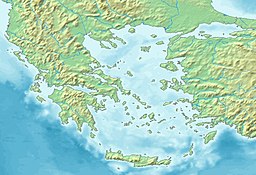
Back Egeïese See Afrikaans Ägäisches Meer ALS ኤጊያን ባህር Amharic Mar Echea AN Egisca Sǣ ANG بحر إيجة Arabic لبحر لإيجي ARY بحر ايجه ARZ Mar Exéu AST Egey dənizi Azerbaijani
| Aegean Sea | |
|---|---|
 The location of the Aegean Sea | |
| Location | Mediterranean Sea |
| Coordinates | 39°N 25°E / 39°N 25°E |
| Type | Sea |
| Etymology | From Greek mythological character Aegeus |
| Primary inflows | Inachos, Ilisos, Spercheios, Pineios, Haliacmon, Vardar, Struma, Nestos, Maritsa |
| Primary outflows | Mediterranean Sea |
| Basin countries | Greece, Turkey; North Macedonia, Serbia, Bulgaria (drainage basins for inflow rivers)[1] |
| Max. length | 700 km (430 mi) |
| Max. width | 400 km (250 mi) |
| Surface area | 214,000 km2 (83,000 sq mi) |
| Max. depth | 3,544 m (11,627 feet)[2] |
| Islands | 150+ |
| Settlements | Alexandroupolis, Athens, Ayvalık, Bodrum, Çanakkale, Çeşme, Chania, Didim, Heraklion, İzmir, Kavala, Kuşadası, Nafplio, Thessaloniki, Volos |

The Aegean Sea[a] is an elongated embayment of the Mediterranean Sea between Europe and Asia. It is located between the Balkans and Anatolia, and covers an area of some 215,000 km2 (83,000 sq mi).[3] In the north, the Aegean is connected to the Marmara Sea, which in turn connects to the Black Sea, by the straits of the Dardanelles and the Bosphorus, respectively. The Aegean Islands are located within the sea and some bound it on its southern periphery, including Crete and Rhodes. The sea reaches a maximum depth of 3,544 m (11,627 ft) to the east of Crete.[2] The Thracian Sea and the Sea of Crete are main subdivisions of the Aegean Sea.
The Aegean Islands can be divided into several island groups, including the Dodecanese, the Cyclades, the Sporades, the Saronic islands and the North Aegean Islands, as well as Crete and its surrounding islands. The Dodecanese, located to the southeast, includes the islands of Rhodes, Kos, and Patmos; the islands of Delos and Naxos are within the Cyclades to the south of the sea. Lesbos is part of the North Aegean Islands. Euboea, the second-largest island in Greece, is located in the Aegean, despite being administered as part of Central Greece. Nine out of twelve of the Administrative regions of Greece border the sea, along with the Turkish provinces of Edirne, Çanakkale, Balıkesir, İzmir, Aydın and Muğla to the east of the sea. Various Turkish islands in the sea are Imbros, Tenedos, Cunda Island, and the Foça Islands.
The Aegean Sea has been historically important, especially regarding the civilization of Ancient Greece, which inhabited the area around the coast of the Aegean and the Aegean islands. The Aegean islands facilitated contact between the people of the area and between Europe and Asia. Along with the Greeks, Thracians lived along the northern coasts. The Romans conquered the area under the Roman Empire, and later the Byzantine Empire held it against advances by the First Bulgarian Empire. The Fourth Crusade weakened Byzantine control of the area, and it was eventually conquered by the Ottoman Empire, with the exception of Crete, which was a Venetian colony until 1669. The Greek War of Independence allowed a Greek state on the coast of the Aegean from 1829 onwards. The Ottoman Empire held a presence over the sea for over 500 years until it was replaced by modern Turkey.
The rocks making up the floor of the Aegean are mainly limestone, though often greatly altered by volcanic activity that has convulsed the region in relatively recent geologic times. Of particular interest are the richly colored sediments in the region of the islands of Santorini and Milos, in the south Aegean.[3] Notable cities on the Aegean coastline include Athens, Thessaloniki, Volos, Kavala, and Heraklion in Greece, and İzmir and Bodrum in Turkey.
Several issues concerning sovereignty within the Aegean Sea are disputed between Greece and Turkey. The Aegean dispute has had a large effect on Greece-Turkey relations since the 1970s. Issues include the delimitation of territorial waters, national airspace, exclusive economic zones, and flight information regions.[4]
- ^ "Drainage Basin of the Mediterranean Sea" (PDF). Second Assessment of Ocean (Report). UNECE. November 2011. Archived (PDF) from the original on 9 October 2022.
- ^ a b "Aegean Sea". Britannica. Encyclopædia Britannica, Inc. 24 June 2024. Archived from the original on 28 May 2023. Retrieved 29 June 2024.
The maximum depth of the Aegean is to be found east of Crete, where it reaches 11,627 feet (3,544 metres).
- ^ a b "Aegean Sea | Mediterranean Sea". Encyclopedia Britannica. Archived from the original on 28 May 2023. Retrieved 14 June 2019.
- ^ "The Greco -Turkish dispute over the Aegean Sea". Indian Council of World Affairs (Government of India). Archived from the original on 28 February 2024. Retrieved 14 January 2024.
Cite error: There are <ref group=lower-alpha> tags or {{efn}} templates on this page, but the references will not show without a {{reflist|group=lower-alpha}} template or {{notelist}} template (see the help page).
